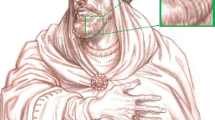Abstract
This paper first introduces a way to improve interactivity with high polygon count virtual objects through the “mixed” use of image-based representation within one object. That is, both 3D polygonal and image-based representations are maintained for an object, and switched for rendering depending on the functional requirement of the object. Furthermore, in order to reduce the popping effect and provide smooth and gradual transition during the object representation switch, the object is subdivided with the subdivided parts possibly represented differently, i.e., using 3D models or images. As for the image-based representation, the relief texture (RT) method is used. In particular, through the use of the mixed representation, a new way called TangibleScreen is proposed to provide object tangibility by associating the image-based representation with a physical prop (projecting the RTs) in a selective and flexible way. Overall, the proposed method provides a way to maintain an interactive frame rate with selective perceptual details in a large-scale virtual environment, while allowing the user to interact with virtual objects in a tangible way.
Similar content being viewed by others
References
Aliaga, D., Lastra, A., 1998. Architectural Walkthroughs Using Portal Textures. Proc. Virtual Reality Annual Int. Symp., p.228–233.
Aliaga, D., Lastra, A., 1999. Automatic Image Placement to Provide a Guaranteed Frame Rate. Proc. ACM SIGGRAPH, p.307–316.
Andujar, C., Boo, J., Brunet, P., Fairen, M., Navazo, I., Vazquez, P., Vinacua A., 2007. Omni-directional Relief Impostors. Proc. EUROGRAPHICS, 6(3):553–560.
Baboud, L., Decoret, X., 2006. Rendering Geometry with Relief Textures. Proc. Graphics Interface, p.195–201.
Bimber, O., 2002. Interactive Rendering for Projection-based Augmented Reality Displays. PhD Thesis, Darmstadt University of Technology, Germany.
Chen, S., Williams, L., 1993. View Interpolation for Image Synthesis. Proc. ACM SIGGRAPH, p.279–288.
Fujita, M., Kanai, T., 2002. Hardware-assisted Relief Texture Mapping. Proc. EUROGRAPHICS, p.257–262.
Grossberg, M., Peri, H., Nayar, S., Belhumeur, P., 2004. Making One Object Look like Another: Controlling Appearance Using a Projector-camera System. Proc. Conf. on Computer Vision and Pattern Recognition, p.452–459.
Ishii, H., Ullmer, B., 1997. Tangible Bits: Towards Seamless Interfaces Between People, Bits and Atoms. Proc. SIG-CHI Conf. on Human Factors in Computing Systems, p.234–241. [doi:10.1145/258549.258715]
Jeschke, S., Wimmer, M., Purgathofer, W., 2005. Star: Image-based Representations for Accelerated Rendering of Complex Scenes. Proc. EUROGRAPHICS, p.1–20.
Low, K., Welch, G., Lastra, A., Fuchs, H., 2001. Life-sized Projector-based Dioramas. Proc. ACM Symp. on Virtual Reality Software and Technology, p.93–101. [doi:10.1145/505008.505026]
Luebke, D., Reddy, M., Cohen, J., Varshney, Watson, B., Huebner, B., 2002. A. Level of Detail for 3D Graphics. Morgan Kaufmann, USA.
McMillan, L.Jr., 2001. An Image-based Approach to Three-dimensional Computer Graphics. PhD Thesis, University of North Carolina at Chapel Hill, USA.
Neider, J., 1993. OpenGL Programming Guide. Addison Wesley Publishing Company, USA.
Oat, C., Mitchel, J., Evans, A., Wenzel, C., 2006. Advanced Real-time Rendering in 3D Graphics and Games. Siggraph Course Notes 26.
Oliveira, M., Bishop, G., 1999. Image-based Objects. Proc. ACM Symp. on Interactive 3D Graphics, p.191–198. [doi:10.1145/300523.300552]
Oliveira, M., Bishop, G., McAllister, D., 2000. Relief Texture Mapping. Proc. ACM SIGGRAPH, p.359–368.
Pair, J., Neumann, U., Piepol, D., Swartout, B., 2003. Flat-World: combining Hollywood set design techniques with VR. IEEE Comput. Graph. Appl., 23(1):12–15. [doi:10.1109/MCG.2003.1159607]
Raskar, R., Low, K., 2001. Interacting with Spatially Augmented Reality. Proc. AFRIGRAPH, p.101–108. [doi:10.1145/513867.513889]
Raskar, R., Welch, G., Cutts, M., Lake, A., Stesin, L., Fuchs, H., 1998. The Office of the Future: A Unified Approach to Image Based Modeling and Spatially Immersive Displays. Proc. ACM SIGGRAPH, p.179–188.
Reddy, M., 1997. The Effects of Low Frame Rate on a Measure for User Performance in Virtual Environments. Technical Report ECS-CSG-36-97. Department of Computer Science, University of Edinburgh, UK.
Schaufler, G., 1995. Dynamically Generated Imposters. Proc. Workshop on Modeling Virtual World—Distributed Graphics, p.129–136.
Schaufler, G., 1997. Nailboards: A Rendering Primitive for Image Caching in Dynamic Scenes. Proc. EURO-GRAPHICS Workshop on Rendering, p.151–162.
Seitz, S., Dyer, C., 1996. View Morphing. Proc. ACM SIGGRAPH, p.21–30.
Shade, J., Gortler, S., He, L., Szeliski, R., 1998. Layered Depth Images. Proc. ACM SIGGRAPH, p.231–242.
Author information
Authors and Affiliations
Corresponding author
Additional information
Project (No. R01-2006-000-11142-0) supported by the “Teukjung Gicho” Program of the Korea Science Foundation
Rights and permissions
About this article
Cite this article
Kim, J., Shin, S. & Kim, G.J. Using relief texture for interactive and tangible virtual environments. J. Zhejiang Univ. Sci. A 9, 1656–1665 (2008). https://doi.org/10.1631/jzus.A0720113
Received:
Accepted:
Published:
Issue Date:
DOI: https://doi.org/10.1631/jzus.A0720113




